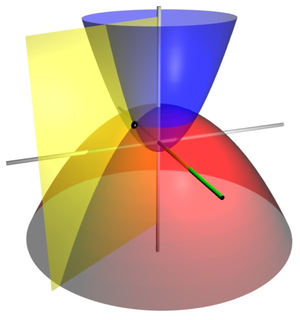Paraboloidal coordinates – Wikipedia
From Wikipedia, the free encyclopedia
Paraboloidal coordinates are three-dimensional orthogonal coordinates
that generalize two-dimensional parabolic coordinates. They possess elliptic paraboloids as one-coordinate surfaces. As such, they should be distinguished from parabolic cylindrical coordinates and parabolic rotational coordinates, both of which are also generalizations of two-dimensional parabolic coordinates. The coordinate surfaces of the former are parabolic cylinders, and the coordinate surfaces of the latter are circular paraboloids.
Differently from cylindrical and rotational parabolic coordinates, but similarly to the related ellipsoidal coordinates, the coordinate surfaces of the paraboloidal coordinate system are not produced by rotating or projecting any two-dimensional orthogonal coordinate system.

Basic formulas[edit]
The Cartesian coordinates
can be produced from the ellipsoidal coordinates
by the equations[1]
with
- are downward opening elliptic paraboloids:
Similarly, surfaces of constant
are upward opening elliptic paraboloids,
whereas surfaces of constant
are hyperbolic paraboloids:
Scale factors[edit]
The scale factors for the paraboloidal coordinates
are[2]
Hence, the infinitesimal volume element is
Differential operators[edit]
Common differential operators can be expressed in the coordinates
by substituting the scale factors into the general formulas for these operators, which are applicable to any three-dimensional orthogonal coordinates. For instance, the gradient operator is
and the Laplacian is
Applications[edit]
Paraboloidal coordinates can be useful for solving certain partial differential equations. For instance, the Laplace equation and Helmholtz equation are both separable in paraboloidal coordinates. Hence, the coordinates can be used to solve these equations in geometries with paraboloidal symmetry, i.e. with boundary conditions specified on sections of paraboloids.
The Helmholtz equation is
. Taking
, the separated equations are[3]
where
and
are the two separation constants. Similarly, the separated equations for the Laplace equation can be obtained by setting
in the above.
Each of the separated equations can be cast in the form of the Baer equation. Direct solution of the equations is difficult, however, in part because the separation constants
and
appear simultaneously in all three equations.
Following the above approach, paraboloidal coordinates have been used to solve for the electric field surrounding a conducting paraboloid.[4]
References[edit]
- ^ Yoon, LCLY; M, Willatzen (2011), Separable Boundary-Value Problems in Physics, Wiley-VCH, p. 217, ISBN 978-3-527-63492-7
- ^ Willatzen and Yoon (2011), p. 219
- ^ Willatzen and Yoon (2011), p. 227
- ^ Duggen, L; Willatzen, M; Voon, L C Lew Yan (2012), “Laplace boundary-value problem in paraboloidal coordinates”, European Journal of Physics, 33 (3): 689–696, doi:10.1088/0143-0807/33/3/689
Bibliography[edit]
- Lew Yan Voon LC, Willatzen M (2011). Separable Boundary-Value Problems in Physics. Wiley-VCH. ISBN 978-3-527-41020-0.
- Morse PM, Feshbach H (1953). Methods of Theoretical Physics, Part I. New York: McGraw-Hill. p. 664. ISBN 0-07-043316-X. LCCN 52011515.
- Margenau H, Murphy GM (1956). The Mathematics of Physics and Chemistry. New York: D. van Nostrand. pp. 184–185. LCCN 55010911.
- Korn GA, Korn TM (1961). Mathematical Handbook for Scientists and Engineers. New York: McGraw-Hill. p. 180. LCCN 59014456. ASIN B0000CKZX7.
- Arfken G (1970). Mathematical Methods for Physicists (2nd ed.). Orlando, FL: Academic Press. pp. 119–120.
- Sauer R, Szabó I (1967). Mathematische Hilfsmittel des Ingenieurs. New York: Springer Verlag. p. 98. LCCN 67025285.
- Zwillinger D (1992). Handbook of Integration. Boston, MA: Jones and Bartlett. p. 114. ISBN 0-86720-293-9. Same as Morse & Feshbach (1953), substituting uk for ξk.
- Moon P, Spencer DE (1988). “Paraboloidal Coordinates (μ, ν, λ)”. Field Theory Handbook, Including Coordinate Systems, Differential Equations, and Their Solutions (corrected 2nd ed., 3rd print ed.). New York: Springer-Verlag. pp. 44–48 (Table 1.11). ISBN 978-0-387-18430-2.
External links[edit]
 that generalize two-dimensional parabolic coordinates. They possess elliptic paraboloids as one-coordinate surfaces. As such, they should be distinguished from parabolic cylindrical coordinates and parabolic rotational coordinates, both of which are also generalizations of two-dimensional parabolic coordinates. The coordinate surfaces of the former are parabolic cylinders, and the coordinate surfaces of the latter are circular paraboloids.
that generalize two-dimensional parabolic coordinates. They possess elliptic paraboloids as one-coordinate surfaces. As such, they should be distinguished from parabolic cylindrical coordinates and parabolic rotational coordinates, both of which are also generalizations of two-dimensional parabolic coordinates. The coordinate surfaces of the former are parabolic cylinders, and the coordinate surfaces of the latter are circular paraboloids.
 can be produced from the ellipsoidal coordinates
can be produced from the ellipsoidal coordinates





 are upward opening elliptic paraboloids,
are upward opening elliptic paraboloids,

 are hyperbolic paraboloids:
are hyperbolic paraboloids:

![{displaystyle h_{mu }=left[{frac {left(mu -nu right)left(mu -lambda right)}{left(mu -bright)left(mu -cright)}}right]^{1/2}}](https://wikimedia.org/api/rest_v1/media/math/render/svg/eaccb1084eddd2db984cf0b052ff7884a4b152b8)
![{displaystyle h_{nu }=left[{frac {left(mu -nu right)left(lambda -nu right)}{left(b-nu right)left(c-nu right)}}right]^{1/2}}](https://wikimedia.org/api/rest_v1/media/math/render/svg/11790f76f35a6ab2b867f3b6729f669170c7ac23)
![{displaystyle h_{lambda }=left[{frac {left(lambda -nu right)left(mu -lambda right)}{left(b-lambda right)left(lambda -cright)}}right]^{1/2}}](https://wikimedia.org/api/rest_v1/media/math/render/svg/39eeb3023b903672606255a46487a7bc90d475f4)
![{displaystyle dV={frac {(mu -nu )(mu -lambda )(lambda -nu )}{left[(mu -b)(mu -c)(b-nu )(c-nu )(b-lambda )(lambda -c)right]^{1/2}}} dlambda dmu dnu }](https://wikimedia.org/api/rest_v1/media/math/render/svg/066e18ddd5cb9b5c58b4fa3dff4f30be027a0e79)
![{displaystyle nabla =left[{frac {left(mu -bright)left(mu -cright)}{left(mu -nu right)left(mu -lambda right)}}right]^{1/2}mathbf {e} _{mu }{frac {partial }{partial mu }}+left[{frac {left(b-nu right)left(c-nu right)}{left(mu -nu right)left(lambda -nu right)}}right]^{1/2}mathbf {e} _{nu }{frac {partial }{partial nu }}+left[{frac {left(b-lambda right)left(lambda -cright)}{left(lambda -nu right)left(mu -lambda right)}}right]^{1/2}mathbf {e} _{lambda }{frac {partial }{partial lambda }}}](https://wikimedia.org/api/rest_v1/media/math/render/svg/ec6410a2adddb953e04da4b3aff0ccfbbc1f13ff)
![{displaystyle {begin{aligned}nabla ^{2}=&left[{frac {left(mu -bright)left(mu -cright)}{left(mu -nu right)left(mu -lambda right)}}right]^{1/2}{frac {partial }{partial mu }}left[(mu -b)^{1/2}(mu -c)^{1/2}{frac {partial }{partial mu }}right]\&+left[{frac {left(b-nu right)left(c-nu right)}{left(mu -nu right)left(lambda -nu right)}}right]^{1/2}{frac {partial }{partial nu }}left[(b-nu )^{1/2}(c-nu )^{1/2}{frac {partial }{partial nu }}right]\&+left[{frac {left(b-lambda right)left(lambda -cright)}{left(lambda -nu right)left(mu -lambda right)}}right]^{1/2}{frac {partial }{partial lambda }}left[(b-lambda )^{1/2}(lambda -c)^{1/2}{frac {partial }{partial lambda }}right]end{aligned}}}](https://wikimedia.org/api/rest_v1/media/math/render/svg/f95e090fef3dd36493eaa9d354a25b85a8159228)
 . Taking
. Taking  , the separated equations are[3]
, the separated equations are[3]![{displaystyle {begin{aligned}&(mu -b)(mu -c){frac {d^{2}M}{dmu ^{2}}}+{frac {1}{2}}left[2mu -(b+c)right]{frac {dM}{dmu }}+left[k^{2}mu ^{2}+alpha _{3}mu -alpha _{2}right]M=0\&(b-nu )(c-nu ){frac {d^{2}N}{dnu ^{2}}}+{frac {1}{2}}left[2nu -(b+c)right]{frac {dN}{dnu }}+left[k^{2}nu ^{2}+alpha _{3}nu -alpha _{2}right]N=0\&(b-lambda )(lambda -c){frac {d^{2}Lambda }{dlambda ^{2}}}-{frac {1}{2}}left[2lambda -(b+c)right]{frac {dLambda }{dlambda }}-left[k^{2}lambda ^{2}+alpha _{3}lambda -alpha _{2}right]Lambda =0\end{aligned}}}](https://wikimedia.org/api/rest_v1/media/math/render/svg/e3b8c185588e8144f23a48b138a5673c4ccbb85b)
 and
and  are the two separation constants. Similarly, the separated equations for the Laplace equation can be obtained by setting
are the two separation constants. Similarly, the separated equations for the Laplace equation can be obtained by setting  in the above.
in the above.
Recent Comments